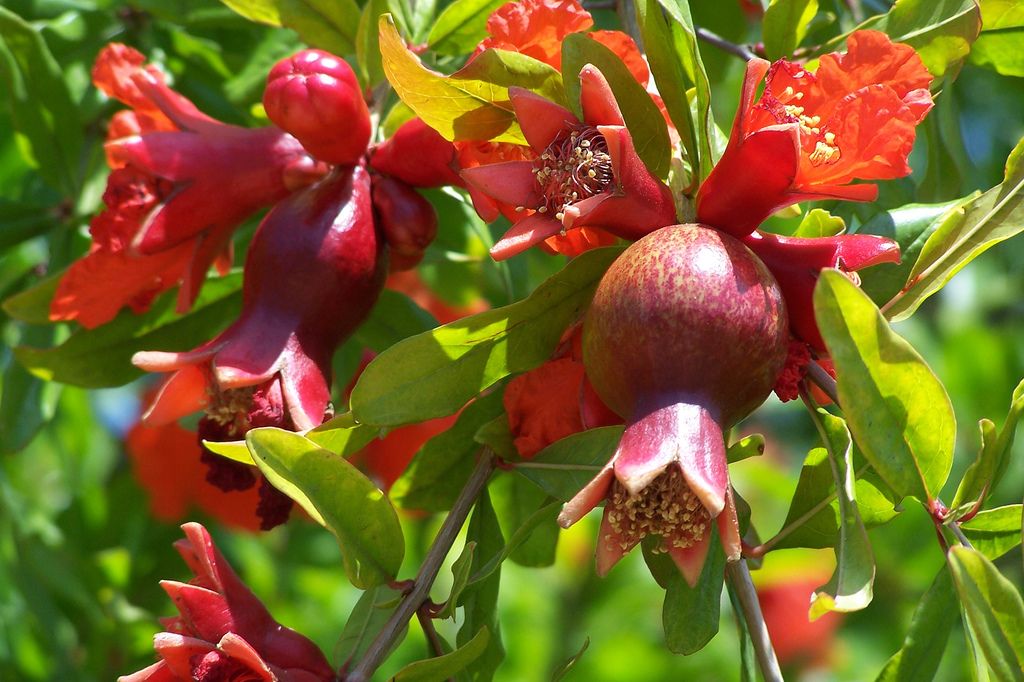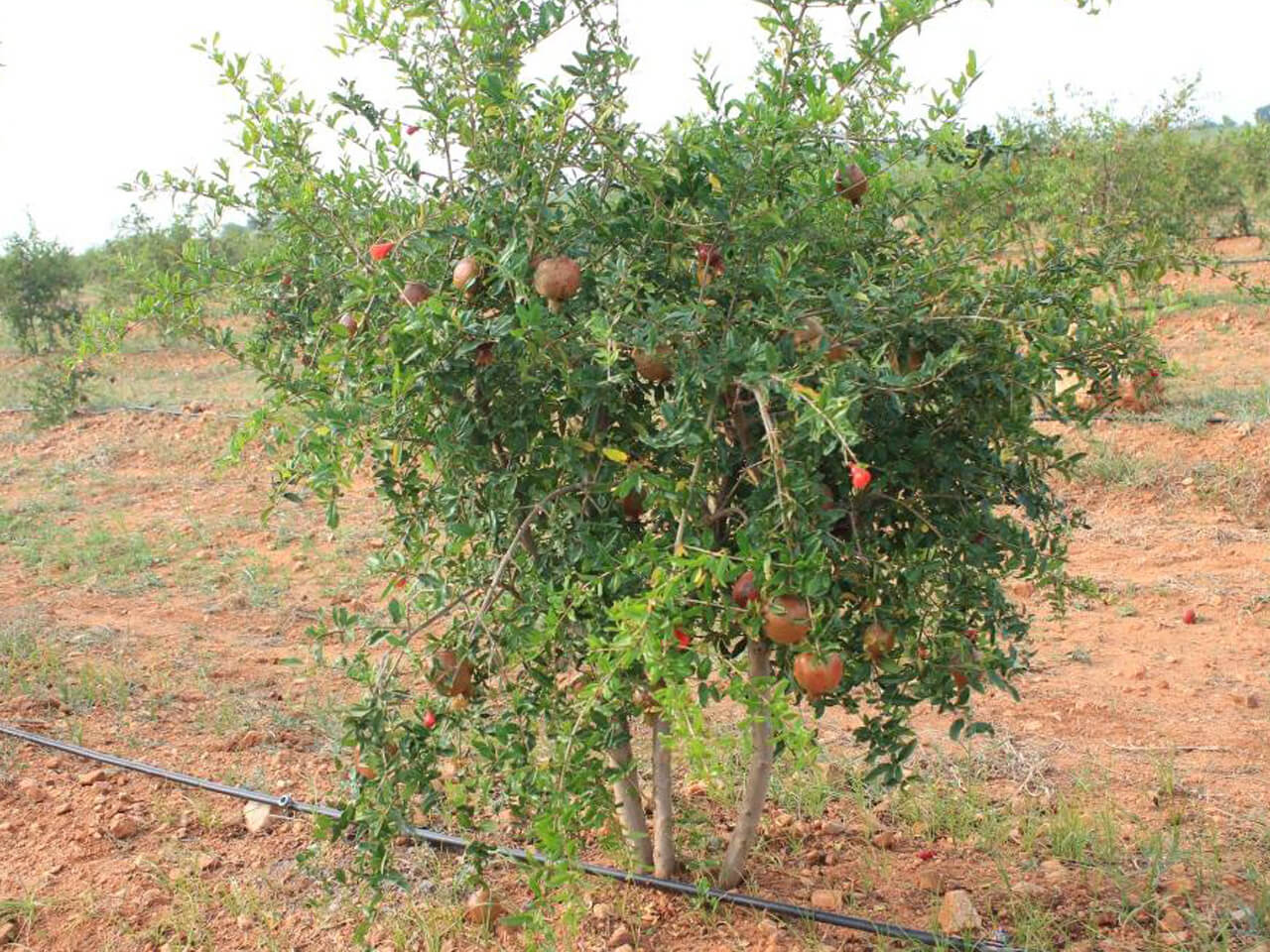
Actionable Tips for Bahar Treatment In Pomegranate That Work Like Booster
- By Agrosiaa Admin --
- Mar 01, 2021--

Let us get to know what actually needs to be done in Bahar Treatment.
1. In BaharTreatment, the irrigation is withheld two months prior to the bahar followed by light earthingup in the basin. This facilitates the shedding of leaves.
2. The trees are then medium pruned 40-45 days after withholding irrigation. The recommended doses of fertilizers are applied immediately after pruning and irrigation is resumed. This leads to profuse flowering and fruiting. The fruits are ready for harvest 4-5 months after flowering.
3. There are two methods used to expose tree against the stress, first by water reduced stress while second is the chemical induced stress.
4. In first method irrigation is completely or partially stopped for 4-6 weeks depending on the soil type and environmental conditions. In this method 50-70% leaf defoliation is expected and considered to be an ideal stage of stress.
5. In second method, Ethephone (Ethrel) the precursors of ethylene is used to spray at 2-5 ml/l concentration over the foliage of the tree. In this method 90-100% leaf defoliation is observed.
6. But we can follow both treatments for the same bahar for complete defoliation.
7. In areas having assured rainfall where precipitation is normally received in June and continues up to September, flowering in June is advantageous
8. Where monsoon normally starts in August with erratic pattern, flowering during August is beneficial
9. The areas having assured irrigation potential during April-May, flowering during January can be taken
10. Where monsoon starts early and withdraws by September, induction of flowering in October is possible.

FLOWERING IN POMEGRANATE PLANT
MrigBahar (June/July)
1. Usually this bahar is favored as the flowering and fruiting period coincides with rainy season or immediately after rains, and the crop is taken without much irrigation.
2. In this treatment, flowering is allowed at the beginning of monsoon. This treatment is well preferred by farmers from arid to semi-arid region where there are limited water resources available.
3. This treatment has some advantages like exposure of tree to water stress becomes easy since plants are exposed to hot summer naturally minimum for 45-60 days where plant can receive required water stress.
4. However, disease and pest management becomes very critical in this treatment because of favorable conditions for the growth of micro-organism, insect and pest. Fungal diseases are predominant because of high humidity.
5. The mrigbahar crop is harvested in the month of December to February.
6. As the fruits develop during the rainy season and mature during winter, the colour and sweetness of the fruit is affected.
Hasta Bahar (September/October)
1. This treatment is followed just after completion of rainy season i.e. during September to October. It has been observed that flower management during Hasta Bahar is very difficult because of unsuitable conditions for giving water stress to the plant.
2. Due to the earlier rainy season, plant accumulates more nitrogen and soil retains some moisture that does not allow plant to receive water stress required to induce flowering. Well drain soils may be considered to be suitable for managing this treatment.
3. This treatment is popular because it gives assured price and high demand for the fruits in the market. The fruits from hasta bahar are harvested during the month of March to April and they have very attractive rind with dark coloured arils. Since the availability of the fruits during this season is limited, they fetch high value.
4. Optimum water stress cannot be developed during this period as withholding of irrigation coincides with the rainy season. This leads to poor flowering and thus affects the yield.
Ambey Bahar (December/February treatment)
1.In this treatment plants are exposed to water stress during December to February depending on variety.
2.This treatment is practiced by the growers who grow their orchards under heavy clay soil. Special attention is required to control sun burn and cracking to the fruit in this treatment.
3.Ambey bahar are ready for harvest in the month of June to September. As the fruit development takes place during dry months, they develop an attractive colour and quality thus suitable for exports.
4.Similarly due to dry weather, the incidences of pest and disease attack are limited.However, Ambey bahar can be taken only areas having assured irrigation facilities.
Irrigation
1.Pomegranate plants respond very well to irrigation. However, water requirement varies from season-to-season.
2.For MrigBahar, first irrigation should be given during mid-May followed by regular irrigation until the onset of monsoon. In post-monsoon period copious and regular irrigation is essential for better development of fruits and to avoid fruit-cracking.
3.For other bahars(seasons), weekly irrigation in summer and bi-weekly irrigation in winter are advised.
4.The check basin system of irrigation should be followed. For arid and semi-arid conditions, micro-catchments should be developed toharvest rainwater.
5.Drip irrigation can also be followed to economize water. Saving in water (43%) and increased yield (30-35%) are observed.

DRIP IRRIGATION IN POMEGRANATE CROP
- High salinity in soils and irrigation with saline water affect normal fruit production in pomegranate.
Conclusion
I hope we understand why we need to do Bahar Treatment to get better flowers and fruits in Pomegranate crop. Thus we should consider the following important points from this article.
1.Pomegranate plant needs to be thrown into rest period so as to enable prolific harvest at a given time.
2.Flowering can be induced during June-July (mrig bahar), September-October (hasta bahar) and January-February (ambey bahar).
3.The choice of flowering/fruiting is regulated taking into consideration the availability of irrigation water, market demand and pest/disease incidence in a given locality.
4.Do proper irrigation management as per season, soil, irrigation source; as Pomegranate plants respond very well to irrigation.
In further articles I will bring you important information about disease management in Pomegranate crop. Until then, stay tuned with us.
See you soon!
Ram Ram!










IMPORTANT LINKS
http://krishi.maharashtra.gov.in/Site/Upload/Pdf/PMFBY__2020_Gr_for_publication.pdf
http://krishi.maharashtra.gov.in/Site/Upload/Pdf/PMFBY_Process_Leaflet_Final_Print_File_15-10-2020.pdf